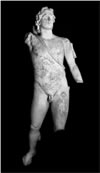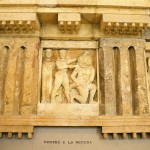 A new exhibit of antiquities on display in the Colosseum is showcasing the long history of Italian efforts to fight tomb raiders from the Renaissance to the present.
A new exhibit of antiquities on display in the Colosseum is showcasing the long history of Italian efforts to fight tomb raiders from the Renaissance to the present.
Some 60 works from Italy and abroad, most dating back to classical times, are arranged on the second tier of the Colosseum.
All these works were originally saved from raiders and traders by art protection movements and laws.
Among them are a 100BC Roman statue called The Haranguer or Orator from Florence’s Archeological Museum; the famous Birth of Bacchus from Budapest; the Gustiniani Hestia statue of an austere noblewoman from Rome’s Torlonia collection; and the ‘Dea Roma’ (Rome Goddess) from Ostia.
Other significant works are the ‘Marciante’ Artemis, recovered in 2001 after a five-year fight against traffickers who commissioned no fewer than five copies in a bid to sidetrack art cops; an Apollo found at the villa of famous Ancient Roman jurist Domitius Ulpianus at Santa Marinella near Rome; and a statue of the tragic Greek mythological mother Niobe from an ancient Roman villa, reunited for the first time with its head, recently identified in Poland.
That’s just the beginning. The exhibit lays out the history of the rise of a sense of Italian cultural patrimony, a feeling which grew from the Renaissance and long pre-dated political unification.
 For example, the British Museum, not satisfied with the fruits of Elgin’s rape of the Acropolis, had its leer fixed on the Doric friezes of the Greek temple complex in Selinunte, Sicily. These friezes are in a unique style and widely considered to be the oldest extant examples of Greek sculpture.
For example, the British Museum, not satisfied with the fruits of Elgin’s rape of the Acropolis, had its leer fixed on the Doric friezes of the Greek temple complex in Selinunte, Sicily. These friezes are in a unique style and widely considered to be the oldest extant examples of Greek sculpture.
They were saved from a fate worst than death by a law passed in pre-unification Italy. The BM had to be content with plaster casts.
Cool, right? I had no idea.
I love the scope of this exhibit. You can’t beat the location, and it’s such great publicity for the Carabinieri art squad, who have done an amazing job addressing the problem of systemic looting of heritage sites not just in Italy itself, but also when they were deployed in Iraq after the invasion.
For more detail on the exhibit, see this New York Times story.